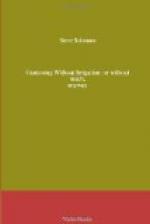For a couple of years, vegetables will grow vigorously on this new ground supported only with a complete organic fertilizer. But vegetable gardening makes humus levels decline rapidly. So every few years I start a new garden on another plot and replant the old garden to green manures. I never remove vegetation during the long rebuilding under green manures, but merely mow it once or twice a year and allow the organic matter content of the soil to redevelop. If there ever were a place where chemical fertilizers might be appropriate around a garden, it would be to affordably enhance the growth of biomass during green manuring.
Were I a serious city vegetable gardener, I’d consider growing vegetables in the front yard for a few years and then switching to the back yard. Having lots of space, as I do now, I keep three or four garden plots available, one in vegetables and the others restoring their organic matter content under grass.
Mulching
Gardening under a permanent thick mulch of crude organic matter is recommended by Ruth Stout (see the listing for her book in More Reading) and her disciples as a surefire way to drought-proof gardens while eliminating virtually any need for tillage, weeding, and fertilizing. I have attempted the method in both Southern California and western Oregon—with disastrous results in both locations. What follows in this section is addressed to gardeners who have already read glowing reports about mulching.
Permanent mulching with vegetation actually does not reduce summertime moisture loss any better than mulching with dry soil, sometimes called “dust mulching.” True, while the surface layer stays moist, water will steadily be wicked up by capillarity and be evaporated from the soil’s surface. If frequent light sprinkling keeps the surface perpetually moist, subsoil moisture loss can occur all summer, so unmulched soil could eventually become desiccated many feet deep. However, capillary movement only happens when soil is damp. Once even a thin layer of soil has become quite dry it almost completely prevents any further movement. West of the Cascades, this happens all by itself in late spring. One hot, sunny day follows another, and soon the earth’s surface seems parched.
Unfortunately, by the time a dusty layer forms, quite a bit of soil water may have risen from the depths and been lost. The gardener can significantly reduce spring moisture loss by frequently hoeing weeds until the top inch or two of earth is dry and powdery. This effort will probably be necessary in any case, because weeds will germinate prolifically until the surface layer is sufficiently desiccated. On the off chance it should rain hard during summer, it is very wise to again hoe a few times to rapidly restore the dust mulch. If hand cultivation seems very hard work, I suggest you learn to sharpen your hoe.
A mulch of dry hay, grass clippings, leaves, and the like will also retard rapid surface evaporation. Gardeners think mulching prevents moisture loss better than bare earth because under mulch the soil stays damp right to the surface. However, dig down 4 to 6 inches under a dust mulch and the earth is just as damp as under hay. And, soil moisture studies have proved that overall moisture loss using vegetation mulch slightly exceeds loss under a dust mulch.




